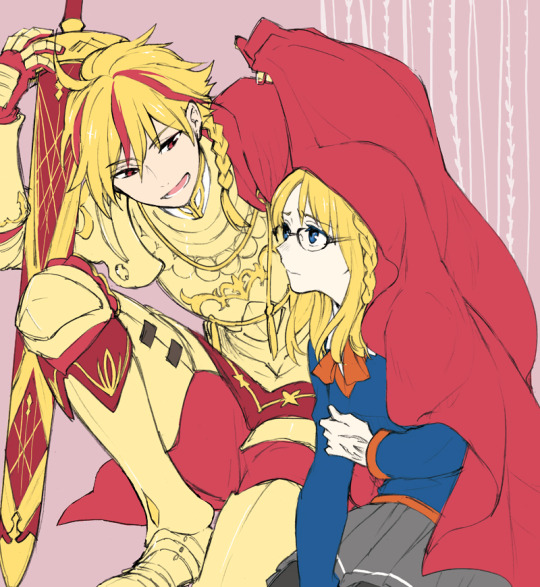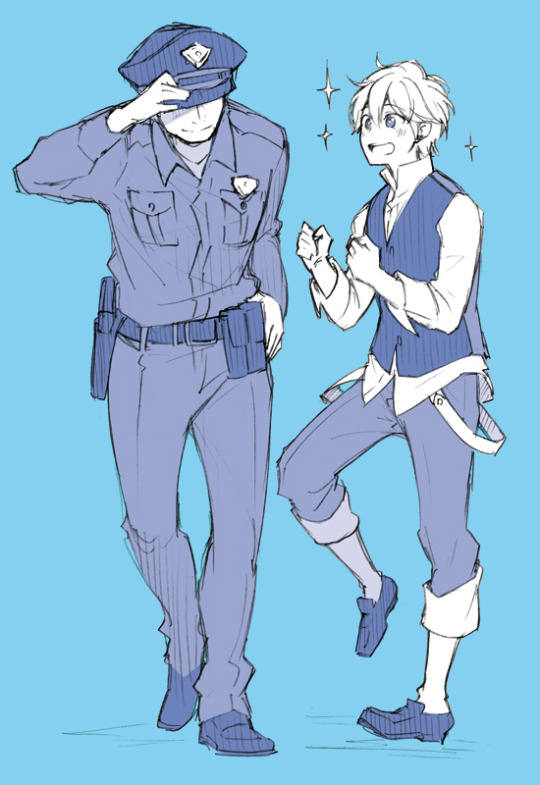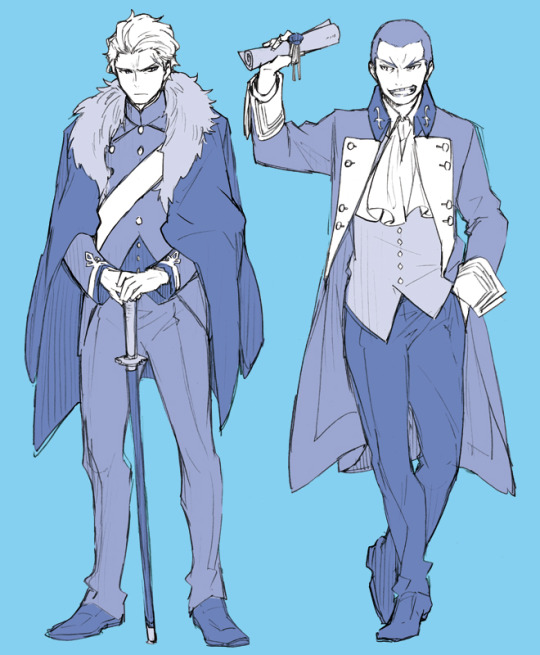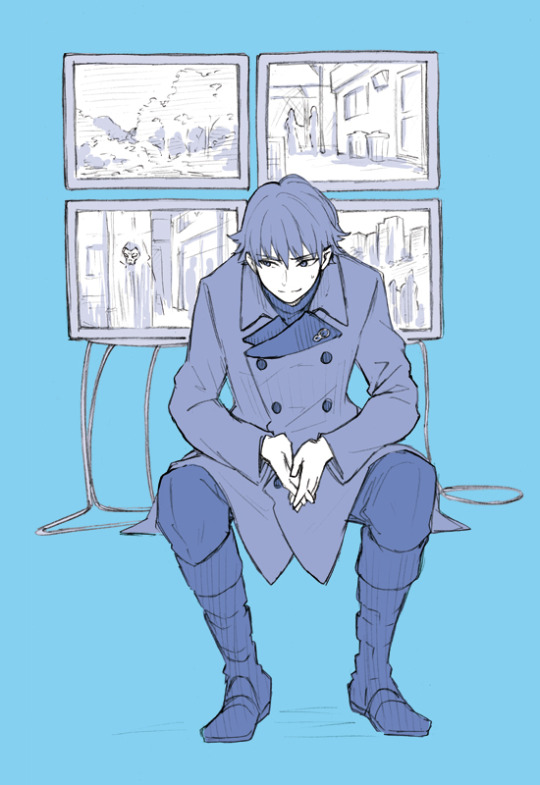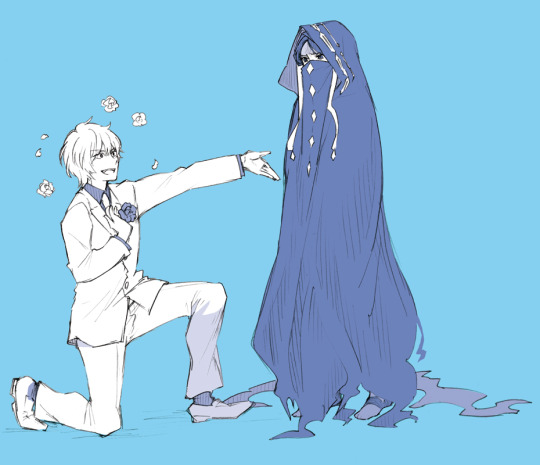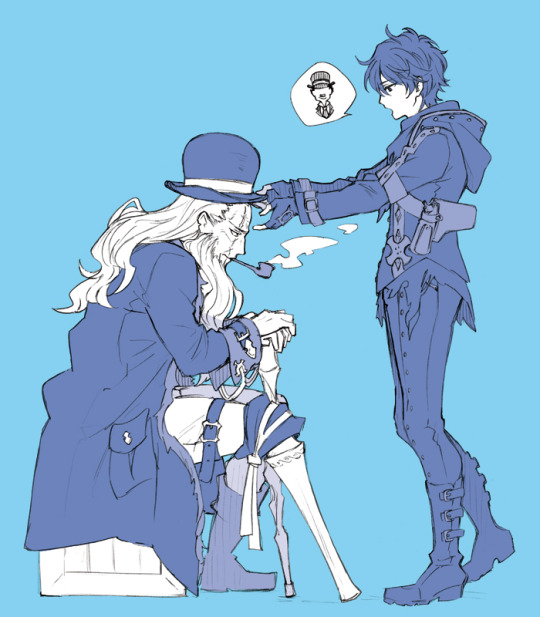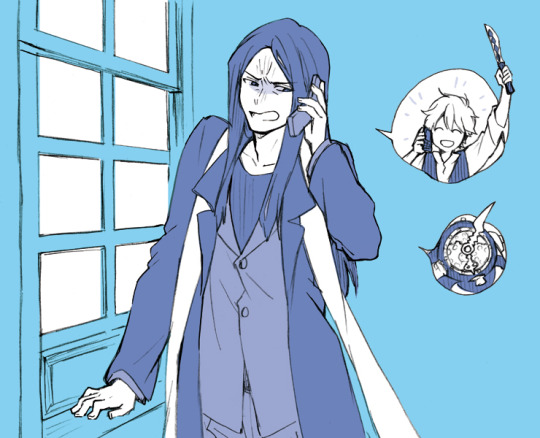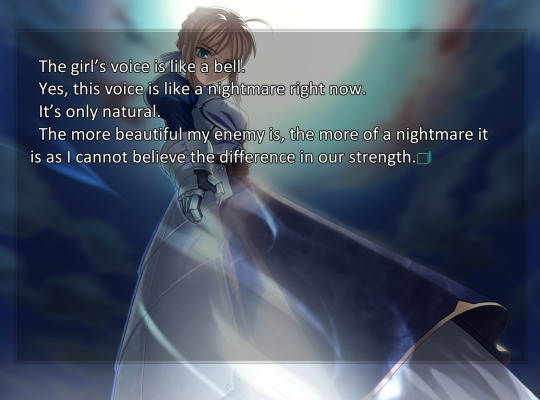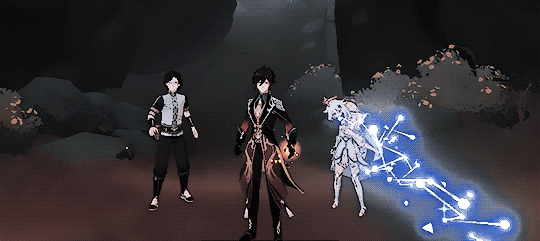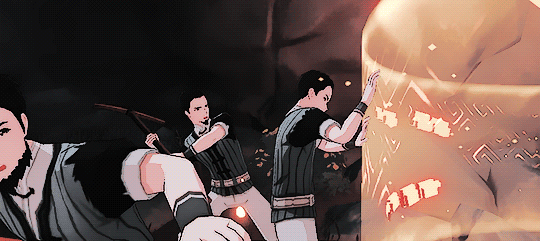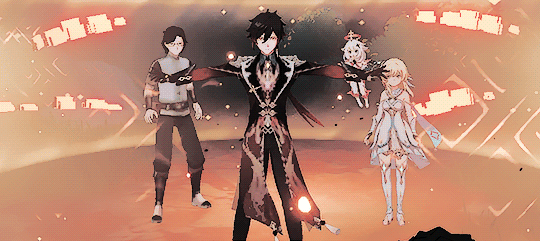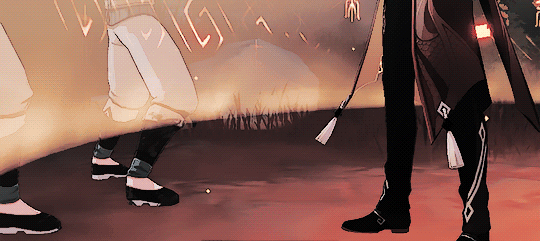Photo




Fate/strange Fake X Durarara!! ED
Happy 10th anniversary!
full picture: https://www.pixiv.net/member_illust.php?mode=medium&illust_id=68030177
475 notes
·
View notes
Text
„A Lady reading Tristan & Isolde“
art by @xinyanfanclub (Twitter/X)
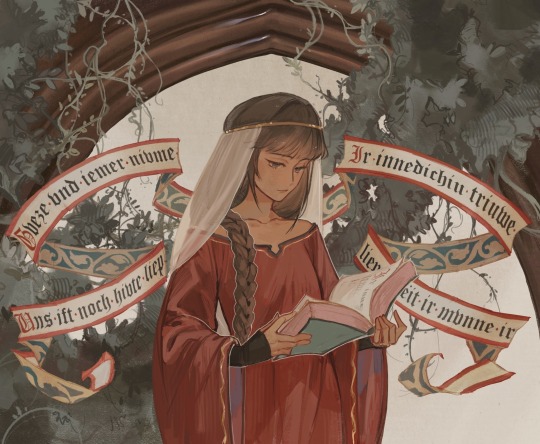

『A Medieval Lady reading Gottfried von Straßburgs „Tristan“, the words on the scrolls are supposed to show the first verses of the Poem in old medieval German language.』 ~ Description based on one of the pop-up books (Serie No.206 - The Bedroom/Tristan Legend) you can purchase in the Neuschwanstein Castle
Based on the August Spieẞ Painting you can find in Neuschwanstein Castle in Ludwigs Bedroom, the room dedicated to the Tristan & Isolde Legend. The Title & the Description felt so perfectly made for a Re-Draw of Medieval Juquia/Me…
32 notes
·
View notes
Photo
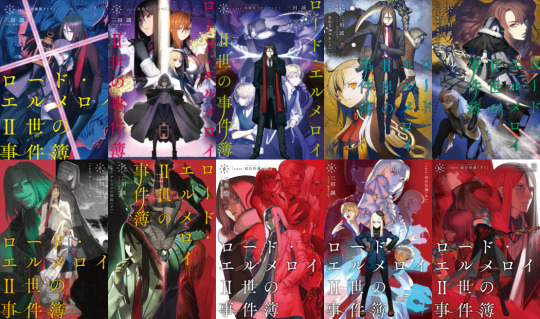
How to read the Lord El-Melloi II Case Files Light Novels
I was recently reminded that there is a lot of people who simply don’t know that they can read the Case Files light novels, and that there are people who do know but have no idea where to find them. This is especially a problem when these people have only watched the anime and want to know where they can find more of the story. Since it kind of requires you to go through some hoops (not a whole lot but still), I decided to take a page out of @humbertozero‘s excellent Fate/strange Fake resource post and make one for my other favorite Type-Moon Fate spinoff, the dossiers of El-Melon.
Read the First Volume: Lord El-Melloi II Case Files Vol.1 (EPUB)
Read the Second Volume: Lord El-Melloi II Case Files Vol.2 (PDF) (EPUB)
Read the Third Volume: Lord El-Melloi II Case Files Vol.3 (EPUB)
Read the Fourth Volume: Lord El-Melloi II Case Files Vol.4 (EPUB1) (EPUB2)
Read the Fifth Volume: Lord El-Melloi II Case Files Vol.5 (TBA)
Read the Sixth Volume: Lord El-Melloi II Case Files Vol.6 (PDF) (EPUB)
Read the Seventh Volume: Lord El-Melloi II Case Files Vol.7 (PDF) (EPUB)
Read the Eighth Volume: Lord El-Melloi II Case Files Vol.8 (PDF) (EPUB)
Read the Ninth Volume: Lord El-Melloi II Case Files Vol.9 (PDF) (EPUB)
Read the Tenth Volume: Lord El-Melloi II Case Files Vol.10 (PDF) (EPUB)
Volume 5 updated (19-02-23): Chapter 5 Part 4. Approximately 86% of the novel has been translated. Important note!
It should be noted first that I am just the compiler here. I am neither the translator nor am I the files’ creator. So all credits go to…
Credits
Credits and thanks to TwilightsCall on the Beast Lair forums (from which the majority of the other creditors originally posted their contributions) for translating the first 4 volumes and some of volume 5, thus getting the ball rolling. Further thanks to azwhoisverybored for translating the rest of the series from volume 6 onwards, and thanks to Kneenaw for starting the translation for the rest of volume 5. Thanks to Dotelias for making EPUBs for volumes 1-3, thanks to cereal_ for making EPUBs of volume 4, thanks to u/confusedkuratowski on Reddit for making EPUB of volume 6, and thanks to ProtoformX for making PDFs and EPUBs for volumes 6 to 10.
And thanks to Makoto Sanda for writing Case Files in the first place!
Further explanations
Volume 5
At this point, you might be wondering what is up with volume 5 and if it won’t hinder you from reading the series. Don’t worry, it won’t, but to explain that, we need to address the anime.
Anime
The anime adaptation of Case Files, with the mouthful of a title that is Lord El-Melloi II’s Case Files: Rail Zeppelin Grace Note, is particular to use as an entry-point in the series, because it only partially adapts the series. See, the author, Makoto Sanda, said in interview that the two first arcs/cases in the series didn’t quite work as scripts for anime episodes, so the anime only adapted the third case/arc, Rail Zeppelin, which is more action oriented than the more mystery focused first arcs. But because they still needed to explain stuff like Gray, Reines, El-Melloi’s students, etc., many of whom are relevant characters to the arc, the first half/six episodes of the anime is about introducing them.
So to the question “where do I start reading after the anime?”, the answer is unironically to restart at volume 1. And then you may skip volumes 4-5 since they are the Rail Zeppelin arc and there are not much differences besides some characters not being present during that arc. This is why volume 5 not being complete at the time of writing is not a huge problem, and why I think you can watch the anime first if that’s more your speed (I have my problems and criticisms of the anime but that’s irrelevant to this post).
And you can’t start with the anime and start reading with volume 6, the first 3 volumes have characters and plot points that come back for the final arc, so you’re gonna be incredibly lost if you think to consume the series this way.
Weirdly enough, despite being original episodes, the anime originals are most likely canon in some ways. Episode 0, the original OVA, is an expansion of an anecdote Gray mentions in the first volume’s prologue, and Episode 1 takes place during Waver’s travels before the story starts and is an actual story, one of the 3 incidents Sanda has in mind for Waver’s journey before he returned to London. Episodes 2 to 6 take place during the one month period between volume 3 and volume 4, and finally the special OVA take place on Christmas also in between arcs.
Manga
The manga has gorgeous art, but, at the time of writing, it is unfortunately only translated up to the second case right now. Still, go check it out.
The Adventures of El-Melloi II
The sequel series currently ongoing, started a year after the first Case Files ended in 2019. You might know it as “the (other) series where Rin shows up grown up and also a pirate”. @reignsan has been compiling pretty thorough chapter-by-chapter summaries of the volumes by @kaibutsushidousha if you don’t mind being spoiled. Or you can be patient and wait for azwhoisverybored to finish translating them on Beast Lair in this thread.
Lord El-Melloi II Case Files material
This is absolutely not required reading in any shape or form, those lore books are usually of interest only to dumb nerds like me lol. A timeline of the Clock Tower? An explanation of its politics? Yes please. But it also has insights into the characters by the author that aren’t in the books proper, as well as behind-the-scenes explanations for some decisions (for example, why it’s Gray with the American spelling instead of Grey with the British spelling). Only the glossary/encyclopedia is translated, but give it a look…after you read the series, because it assumes you did and has some big spoilers.
Drama CD
What’s that? You heard something about a Buzzfeed quizz about the most handsome Clock Tower teachers and how it’s somehow a plot point? Look no further than one of my only posts that did numbers. Read the summary, it’s hilarious.
1K notes
·
View notes
Text

Mahou Tsukai no Yoru - Witch on the Holy Night will be released on PS4 & Nintendo Switch in 2022, now also fully voiced.

Dead Apostle Noel and Aoko Aozaki will be added into Melty Blood: Type Lumina on January 13th.

Type-Moon’s Comiket 99 merchandise, including a Tsukihime fanbook, are now available for preorder online.

Tsukihime: A Piece of Blue Glass Moon comic anthology has been released, and can be bought on Amazon.

A fan group called Tsukihimates is working on the English translation of TsukiR, and has released a partial patch for Arcueid’s days 1-5. You are expected to have your own copy of the game, as this is only an English patch for the game.

The cover arts for the third volume of The Case Files of Lord El-Melloi II & the fifth volume of Fate/Strange Fake have been shared. The Case Files volume will release on January 28th with a price of 1650 yen & the Strange Fake volume will release on February 10th with a price of 1210 yen.

Miyamoto Musashi (Saber) has been added to FGO Arcade

The first chapter of the UBW manga is out, the second chapter is released on January 27th.

FBates, who is retranslating the Fate/Stay Night VN, has released a translation patch for the prologue and the Fate route. You are required to use the Ultimate Edition which has a wider screen. Help for installing can be found on BL & reddit.
135 notes
·
View notes
Video
Jinako’s Despair (CCC)
Jinako : I won’t…I…I’ll never say it! I’ll never ever ever say it!
Jinako : It’s not my fault the old man died! He was dead from the beginning! No matter what — no matter what we do, we won’t be saved!
Jinako : Even if we regret it now, nothing and no one, not my papa, not my mama, not my time, not even that annoying old man… will ever come back!
Jinako : I won’t disappear. I won’t go outside. I’ll just stay like this, forever!
Jinako : Ahh, ah, ah — aah, ah — …ah…fine…fine then, I don’t need anything anyway!
Jinako : KARNAAAAA!!! Throw them out!!! Erase them from the world so they never come here again!!
Karna : …If that’s your order, I will obey. By the tyranny of my spear, Hakuno Kishinami will be burnt away to nothing.
Karna : If you declare that the dark flame within you will not vanish until it burns you up with it, Jinako, then I will be the shroud that guards you from the wind and rain.
Spear flashes
Karna : Let’s go, King of Heroes. It’s premature, but know that this will be the place of your death.
original BGM of that lostbelt4 karna vs ashwatthaman remixed battle scene plays.
—-
amazing voice acting ugh one of the best scenes
video source: twitter.com/index5453
text source : tsukinoura.wordpress.com
555 notes
·
View notes
Photo






doodled some simplified personal blogs of some servants out of fun (゜∇ °)
1K notes
·
View notes
Note
What are the cues you take to identify which writer is writing each event in FGO?
FGO writers tend to be very self-indulgent in what they do, so each of them has their very clear set of tells in their writing. Typography tells are the most reliable way to single a writer out, but character or theme/trope bias can also be a factor. Here’s a mostly comprehensive list of what I consider to be the biggest tells for each of them.
Cut for length because this somehow was 5 whole pages on Microsoft Word even with me cheating on Nasu’s section.
Yuuichirou Higashide
Higashide is the most vanilla out of FGO’s main writers, so my trick to identify his parts is the process of elimination. If the text doesn’t seem to be anyone else’s, then it should be Higashide’s. That said, Higashide is not completely devoid of personality. He still has his favorite tropes.
The most (in)famous Higashide trait among the Japanese fandom is his involvement in a lot of furry content before he became a Type-Moon writer. If you check the list of character creators in FGO Mats, you’ll see that every FGO-original furry or scalie character was created by Higashide, with the sole exceptions of Tiamat and (to my complete surprise when fact-checking) Red Hare. NOTE: FGO Mats VIII is the most recent volume as of this text’s writing.
I’m bringing this up because some fans correctly guessed Yuga Kshehtra wasn’t Higashide’s by the fact there was no furry character. In contrast, Orleans had Eliza and Atalanta, Orleans had Asterios, Orion and Atalanta, E Pluribus Unum had Eliza and Cu Alter, Shinjuku had Lobo, and Anastasia had, well, almost the entire cast and population.
Higashide is also very openly an avid fan of B movies, and likes to show that off every now and then, like with the chapter titles in E Pluribus Unum, the whole setting in Shinjuku, and the horror movie commentary from Chaldea Thriller Night, not to mention his constant big action set pieces. Maybe as a consequence of that, maybe as a consequence of him writing the first chapter of each part, his stories tend to be a lot more low-scale, humorous, and light-hearted than others. He knows how and when to be serious, but he he’s humorous more often than not. Think of Moriarty’s character as a microcosm of his writing.
One noticeable pattern in his main story chapters is that all of his main villains have been duos, usually following a pattern of a sympathetic villain being manipulated by a viler villain. Orleans starts the trend with Gilles lying to Jalter about what she is, Okeanos follows up with Medea Lily lying to Jason about the consequences of sacrificing a god to the Ark, E Pluribus Unum subverts it with a last-minute reveal that Cu Alter wasn’t being manipulated by Medb at all, Shinjuku moves away from the manipulation trope by having Moriarty and Bael be allies on equal terms, and then Anastasia returns to the formula by having Kadoc force Ivan to sleep and lie to him about the current state of Russia.
Hazuki Minase
Putting in simplest terms possible, Minase feels less like a real human being and more like a walking otaku stereotype, in all the good and bad that entails, mostly the bad. I won’t go into detail about the flaws of Agartha because everyone already talks about that a lot. I will say, however, that while Minase is as insensitive as he can get about sexual matters, like the otaku stereotype he is, he can write sensitively enough about problems otaku are known to suffer, like the ableism that is the central theme of Yuga Kshetra.
Overall, Minase’s best feature is that he responds amazingly well to criticism. Or at least that’s the only way I can justify the quality gap between Agartha and Oo’oku/Yuga Kshetra. Also explains why Minase’s supervised writing feels so similar to Kinoko’s own. Makoto Sanda once made a tweet explaining how Nasu’s supervision works, saying that for the 10 volumes of Case Files he wrote, Nasu hit him with hundreds of “Are you sure?”s, but never with a single no, so in that vein, I like to believe that Minase is the one guy who takes every single “are you sure?” as a “You must change this”. Nasu’s huge respect for his coworker’s creativity (or spinelessness, if you prefer to interpret like that) might have put things he didn’t like into his universe, and Minase is definitely to blame for a big part of it, but I’d like to believe that at least him follows the supervision strictly. Either way, EoR’s gimmick is that each of FGO’s main writers was allowed to write a whole chapter completely unsupervised only once, so Agartha is not something that can happen again.
In terms of character creation, I’d say Minase is the most simplistic of the five. All of his characters clearly begin with one core idea, and everything else revolves around that initial concept, while also staying true to its historical/mythological counterpart. Of course, this model can easily backfire and make his characters one-note, however. Minase is also decently knowledgeable about his character’s stories but takes an overly “show don’t tell” approach to that, causing problems like Nezha’s role in Yuga Kshetra. Nezha’s part is entirely defined by his relationship with Li Jing, but FGO never stopped to define who Li Jing was, so Nezha’s conflict might be hard to understand to people less familiar with the Investiture. He also never stops to explain the cultural background that explains why Altjuna is so ableist, but that ties into his other core character creation trait, that being that he’s the writer who is the least afraid of making his characters utterly unsympathetic, as better evidenced by Columbus and Wu Zetian.
In terms of style, Minase’s most noticeable trait is giving the reader constant access to the character’s inner thoughts. Other writers also do that, but it’s a lot more omnipresent in Minase’s stories. Oo’oku’s Kiara and Yuga Kshehtra’s Pepe felt like they have more inner monologue than spoken dialogue. He’s also a strong believer that the tensest and most climactic moments are the best moments for jokes, no matter how much you’re thematically shooting yourself in the foot. Being the human otaku stereotype he is, he constantly makes and references internet jokes, even with characters that aren’t appropriate for that kind of humor, like Goredolf or Nero.
On the otaku humor repertoire, his favorite trope is the idea that headpats are the ultimate expression of love. No work of him can go without this trope. Agartha? We headpat Zetian into stopping being evil. Oo’oku? Tsubone’s right there constantly rewarding us with motherly headpats. Yuga Kshehtra? William Tell headpats Indian children to show his unshakable dadness. Akihabara Explosion? Hime demanding headpats as a reward for winning her game, and Aphrodite trying to headpat Nero to get on good terms with her. The head petting is the most failproof mark of Minase’s writing.
Another, more unfortunate, side of his overuse of otaku tropes is the fact his authorial voice is very uncomfortably horny towards the gender non-conforming characters. You’ve seen Astolfo and D’Eon’s treatment in Agartha, and you’ve seen Fujimaru getting a first-person narration scene just to call Pepe hot in Yuga Kshetra. You know he’s not very respectful.
One pattern I noticed in all his stories is that the villain’s ultimate goal is, direct or indirectly, suicide. Scheherazade and Phenex were plotting to erase Mystery to give themselves one final death they would never return from. Kama wanted to oversaturate the world with love until love lost its meaning, causing herself to stop existing as a concept. Altjuna wanted to reset the world until it was rid of everyone flawed, while subconsciously seeing himself as another flaw that needed to be erased. The Sculptor King from Akihabara Explosion didn’t have suicide as a goal per se, but she was perfectly fine with including her own death as part of the plan to reunite Galatea and Pygmalion. And while not villains, it’s also easy to see those melancholic, almost suicidal undertones in other Minase-written characters, like Ashwattaman and Aphrodite.
As for typography fingerprints, Minase almost always starts the scenes outside of Fujimaru’s perspective with a textbox saying ~一方そのころ~ (meanwhile), which is super easily identifiable.
Hikaru Sakurai
Sakurai is by a huuuuuuuuuuuge margin the easiest FGO writer to identify typographically. She’s extremely addicted to using archaic language, and even her characters who speak in modern Japanese will still use outdated kanji for words that aren’t normally written in kanji. If you see an 嗚呼, 此処, or a 何故 instead of the usual ああs, ここs, and なぜs, you can be 99% confident Sakurai wrote this text. For all her writing is close to Minase’s in terms of long-windedness, repetition, and faux-poetic prose, the archaic kanji is unmistakable. That’s all honestly. I’ll still talk about her favorite tropes and themes, but you can skip that because you’ve already read everything you need to know to identify her text from a mile away.
Other things she shares with Minase aside from the pretentious style are a sense of scale seemingly designed to drive the vsbattles crowd insane (as every fantasy writer should, honestly), and more recently a lack of qualms to make some of her villains utterly irredeemable. That said her Douman and Dioscuri are much more cartoonishly villainous than Minase’s Mr. Slavery, Ms. Real Methods of Torture, and Mr. Kill Only the Disabled (at least Dioscuri when written by Sakurai. Meteo’s Dioscuri is very realistically uncomfortable, but I’ll get to that in Meteo’s part).
While all the other writers like to sell Fujimaru as a completely normal guy doing abnormal things, Sakurai takes the complete opposite direction, constantly reminding the reader that Fujimaru is a super special guy who can connect to worlds through dreams, whose blood is toxic to gods, and who has their edgy boyfriend The Count of Mount Cristo installed in his head. No Sakurai story is complete without a random and pointless Dantes cameo, which really sucks because I used to like Dantes a lot but now she’s conditioned me to stop expecting things from him.
Sakurai is the one writer who very much has one favorite theme, that being love, and she honestly can get quite a bit of variety out of it. I haven’t fully read ProtoFrags yet, but judging by what I know about Manaka, Brynhild, and Serenity, it seems to be mainly about excessive love being expressed in destructive manners. Then Gotterdamerung is about a pseudo-otome game starring a girl who can’t tell the difference between love and emotional abuse. Then Olympus about a family where the father has lost the ability to love. Then Heian is about a man failing to become a Beast because he’s devoid of love for humanity. I also hear a lot of people saying she’s tangibly influenced by Utena, and haven’t watched that to know what they’re talking about, but I’ll assume it’s this part.
Like Nasu, she likes make characters bond through the sharing of food, although she’s far less descriptive about her food than Nasu. Think of Shimousa’s dinner scenes on Muramasa’s house, Gerda’s offering of food in Gotterdamerung, the two dinner scenes with Adele and with Europa in Olympus, and even the lunch Manaka cooked for Arthur, which is her first real character moment.
Another interesting (more so in theory than in practice) trait of Sakurai is that she likes to be creative with the setting mechanics. While Higashide’s Singularities all had Goetia finding a person who can use the Grail and handing it to them, Septem had Lev failing to find anyone and having to use the Grail himself in hope something good happens, London had Goetia giving the Grail to a very unwilling Zouken who sabotaged his plan, and Camelot (which she co-wrote mostly on the Egyptian side) had a whole Singularity that happened before the player arrived. Later her EoR is completely unrelated to the surviving Pillars, and her Lostbelt has its kingship shift twice. Weirdly enough, Olympus is her most mechanically standard chapter, although she compensates for it later in Heian, by making a Grail War with 7 historical hero Masters and 7 Caster Servants.
Last but not least, a favorite trait of her making her villains stupid, and that usually is the cause of our victory. And that’s not a case where the villains feel stupid because the writer is stupid. Sakurai always makes a point to show she’s actively making her villains dumb and incompetent. In Septem, we can fight all the enemy emperors one by one because the enemy side doesn’t have a plan, as Lev points this out as he complains he couldn’t find anyone to receive the Grail. London’s biggest reveal was about how Zouken duping the dumb Goetia by creating the slowest doomsday plan ever and stalling it further by forcing Tesla to power walk instead of flying. Shimousa has Douman brainwashed 4 Servants with oni blood with a spell incompatible with oni, allowing them to retain a bit of free will (or all of it for the full-blooded oni Shutendouji) and fixed Danzou, which gave Fujimaru a helpful ally and stabilized Kotarou’s presence. Shimousa even makes a point to include a scene of Musashi pointing out to Douman exactly how much all of his mistakes helped us. While not too tied to the cause of our victory, Gotterdamerung has moments of Surtr cursing his limited intellect, that is physically unable to think of anything other than his flames of destruction to offer to his dear Ophelia. And lastly, Olympus has us killing all mechgods one by one, as the gods can’t gang up on us because they can’t look seriously threatened to their population, and Beryl is there to point out how stupid and impractical their strategy is.
Meteor “Meteo” Hoshizora
Meteo’s most easily identifiable typographical quirk is that the man is absolutely addicted to the English language. Whenever you see unnecessary English on your FGO text, immediately suspect Meteo.
Another huge clue that a story was written by Meteo is character bias. That’s a thing literally all 5 here have a lot, but for some reason, I feel that Meteo is the one who does this the most. Maybe it’s because of the whole colosseum audience scream “Circe best girl” in Requiem. Anyways, every time I see Circe, Sanson, Voyager, or Mephistopheles in a story, I immediately suspect Meteo. He also loves randomly inserting Hollow Ataraxia content, especially Caren content. The moment I read Nasu saying “I only wrote one (1) of Caren’s My Room lines” in his blog, I immediately knew who wrote her and her event.
One thing about Meteo that so far still hasn’t come up much in FGO is that he’s very open about pink hair being his main fetish. For the original Apocrypha project, he shamelessly made both of his characters (Astolfo and Fran) pink-haired just because he could, and even now he makes no efforts to hide his Circe favoritism. I take him as a suspect of writing Nightingale’s Christmas Carol just because both leads have pink hair (Higashide is still the prime suspect though).
On the visual side, you could say he’s the theater kid reject of the FGO writers. He really loves his stories o have amazing unique visual assets. Just look at the screen frames for the theater scenes in Salem and Jeanne scenes in Las Vegas, the special art style for Circe’s flashback scenes in Aeaea, the whole animated intro to Slapstick Museum. Meteo clearly wanted to be a director instead of just a writer. (Note: check the Circe image also as an example of his unnecessary English)
Meteo seems pretty knowledgeable of his history and mythology, but he actively chooses to give no attention to what’s irrelevant to his story. The character profiles for his characters in FGO mats are as barebones as he can get away with, probably for that reason. He also has a very unique way of presenting mythological exposition. Instead of simply dumping the lore like Sakurai and Higashide often do, Meteo makes a character ask “Hey Fujimaru do you know <character>?”, and makes the player chose “Yeah, I already know” or “Tell me”. I have no idea why this a Meteo trait instead of the common practice among the writers.
As for recurring tropes in Meteo works, the man has 2 very distinctive ways of writing humor. The first way is probably doing drugs. That’s how you get stuff like Salem’s theater scenes, SUPER BABY CAREN, and whatever were going on with Jeanne in Las Vegas. The second way is building an extremely cautious and intellectual party except for 1 loose cannon that throws them all into danger. We had Nezha in Salem, Arjuna in Aeaea, and then Amakusa in Slapstick Museum as a subversion because despite being the loose cannon, Amakusa always knew exactly what he was doing.
That said, even in stories like Atlantis, that don’t play this joke, Meteo’s parties are still very noticeable more cautious than FGO’s standards, especially Fujimaru. While Nasu’s Fujimaru is shadowboxing Hundred Personas Hassan behind her back and lariating Quetzalcoatl from the sky, Meteo’s Nasu makes sure to double-check with their Servants before doing literally anything. Looking at how Erice is, I guess Meteo just prefers writing hesitant protagonists. Overall, Fujimaru’s IQ just triples whenever Meteo touches FGO’s writing tool. Meteo’s Fujimaru is so cultured that Hopkins once dropped a random Bible quote to mock them, and they recognized it as the Bible. Please pick the “I already know all the lore” option whenever you can with Meteo’s Fujimaru because that’s the only way to stay in character.
One last, more potentially upsetting thing about Meteo is that he’s the writer least afraid of handling touchy subjects, as shown by him combining the two very racially charged subjects of the Salem Witch Trials and Cthulhu Mythos. That said, Meteo is not clueless about what he’s handling in any way and shows that he can be pretty sensitive about his topics when he wants to. The keywords here are “when he wants to” because Meteo can get really nasty on purpose sometimes. When Minase has Fergus saying men and women make babies together, I just thought he’s an imbecile, but when Meteo makes Dioscuri torture Caenis while telling him he’s nothing more than a woman who only gained any worth by being raped, I can tell all the discomfort of the scene is completely intentional. Whether this makes things better or worse is up to your personal judgment.
Non fact-checked addendum: Speaking of uncomfortable, I’ve heard from LiarSoft fans that Meteo is the only FGO writer with a history of writing loli/shota porn before he became a Type-Moon writer, and that explains a lot about Abbigail, and to a lesser extent Voyager and Erice.
Kinoko Nasu
Nasu is the easiest writer to reliably identify because we’re always officially told about his work. We either get told in advance a chapter will be his as a way to build up hype, or he goes on this blog saying “Hey, I wrote this!”. I honestly never bothered looking for marks in Nasu’s typography because he’s so open about what’s his. I don’t feel like I need to talk about his favorite themes because a lot of people on this website are already constantly doing it much better than I could, and I don’t want to talk about it either because I’d have to cover 8 whole games aside from his FGO chapters and FGO’s overarching narrative.
Thank you Nasu for making my job easier.
618 notes
·
View notes
Photo




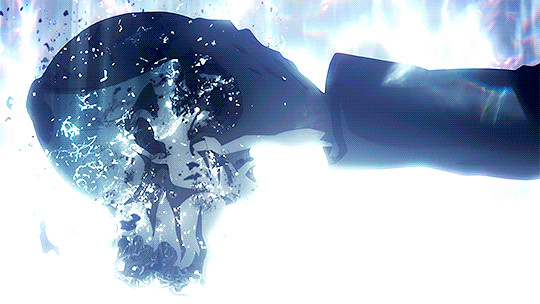
“I will kill. I will let live. I will harm and I will heal. None shall escape my grasp. None shall escape my sight. Be crushed. I welcome those who have grown old and those who have lost. Devote yourself to me, learn from me, and obey me. Rest. Do not forget song, do not forget prayer, and do not forget me. I am light and relieve you of all your burdens.”
“I see, so you will kill me?! Very well, do as you wish. But what will change? Do you think your wish will come true?”
“Do not pretend. Retribution for forgiveness, betrayal for trust, despair for hope, darkness for light, dark death for the living.”
“Hahahaha! Such a hopeless wretch! Do you still seek mundane happiness?! Do you not understand that such a thing does not exist for you?!“
“Relief is in my hands. I will add oil to your sins and leave a mark. Eternal life is given through death. Ask for forgiveness here. I, the incarnation, will swear.”
“You will never find it. Kirei, you were defective from birth. Just stand and watch, never fitting into the world…!”
“— Kyrie eleison.”
451 notes
·
View notes
Photo





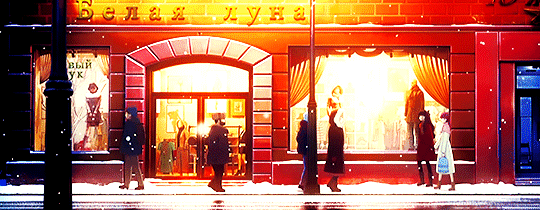
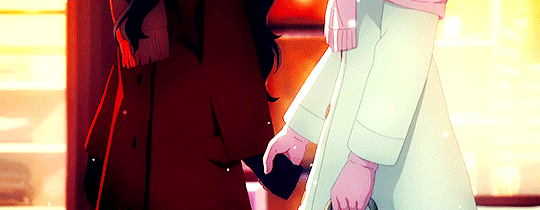
The Holy Grail War that happened on this land has ended. The Greater Grail collapsed, and the curtain has fallen on everything. As I ran about dealing with the Mage’s Association for its aftermath, I waited for Sakura to recover. And now, I’m walking together with Sakura. As if we were trying to regain the eleven years we lost. I walk together with Sakura in the time that has started moving.
2K notes
·
View notes
Photo
Noticed how Xiao is the only one that’s looking at Aether.

148 notes
·
View notes
Text
Type-Moon MC Guide 2015 (Part 2)
Here’s part 2 which would cover the MCs from the spin-offs and other special titles!
Updated and edited again.
Fire Girl:
Protagonist: Homura Hinooka

Since I’ve been reading Fire Girl on my spare time (which isn’t much), lemme just say that Homura’s one of those rare, really well-written, non-otaku pandering light novel heroines/ female main characters who actually have decent and complex personalities (doesn’t fall under the stereotype of the -deres). If you want to know what her personality’s like, I’d say that she’s a three way cross between Kumiko Oumae from Hibike! Euphonium (snark-wise, (though she’s less loudly blunt and more polite) goofy-wise and motivational-wise. Her relationships with her friends is also reminiscent of Kumiko’s relationships with hers, novel-wise at least), Yui Yuigahama from Oregairu (popularity-wise among her peers as well as her plucky attitude in general, but not to the same degree, and book-dumbness in school, though Homura’s bad grades are brought on more by laziness than actual stupidity) and Houtarou Oreki from Hyouka (both are slackers who’d rather not do much to waste energy and are quite the cynics, at least internally, though its downplayed a little in her case).
Her closest counterparts within the Nasuverse would be Hakunon Kishinami from Fate/Extra (MC suddenly thrown into an adventure. Homura’s more proactive when it comes to talking though), Rin Tohsaka and Shirou Emiya from Fate/Stay Night (has their wit in monologues. She’s like Rin minus the tsun; like her, she’s a difficult person to wake up in the mornings, is popular with boys, plus she also has a little sister to boot. Like Shirou, she’s suddenly thrust into the world of adventure after Touya seeks her out to invite her to the club, which she, like Shirou, refuses at first but is actually secretly excited about the prospect until she relents. She also has elements of his naivety), and a bit of Ayaka Sajyou from Fate/Prototype, who is basically Shirou and Rin as one person (like them, she has the tendency to attract people of the opposite gender no matter what she does, plus the whole thrust into adventure thing).
What makes her even better? As a character from the Nasuverse, she’s a certified badass. Without spoiling much, Homura takes on a powerful and much more experienced Witch in the 2nd half of the first volume without hesitation and succeeds in fighting against her evenly in their climactic fight through sheer strategy and willpower (she was losing in her first encounter with her until they stopped, of course, she was just a rookie Magician after all). She also wasn’t the only antagonist she faces there either, so if you want to find out just how badass this girl is, read the novels (the link is in one of the Fire Girl posts, check it out).
Kagetsu Tohya (Ten Nights of Dreams):
Protagonist: Mostly Shiki Tohno, but since this was more of a bonus disc than anything, he shares the position with the other characters, like Len, Akiha (her story there is an epilogue to the True End of her route in the original Tsukihime), her underclassman Akira Seo (unrelated, maybe, to KnK’s Shizune Seo), and Shiki’s deceased biological father, Kiri Nanaya, as well as Kouma Kishima, the Nanaya clan’s murderer.

Kouma Kishima

Akira Seo

Akiha Tohno

Kiri Nanaya
Melty Blood and all its Other Installments:
Protagonist: Everyone gets their turn, but the bulk of MB’s story is heavily reliant on Sion Eltnam Atlasia’s plot and the focus on the two Lens (White and Black respectively) present there.

Sion Eltnam Atlasia

White and Black Len (and Arcueid at the back)
Playing Melty Blood, you get to use all (except one who doesn’t appear there despite his importance) the Tsukihime characters plus some new ones like the MCs above. While they all get their turns in being MCs, Sion stands out for having an involvement in the existence of the antagonist (Dusk of Osiris) and her plot of finding a cure for vampirism. On the other hand, the Lens (both of them) are the main focal points in the conflict with the weird, dreamy things going on in Misaki City, with White Len being the direct cause of the problems in one of the games, and Black Len going out of her way to oppose her.
Tsuki no Sango (Coral of the Moon)
Protagonist: “Hime”/ “Princess” or Storyteller Girl (no given name)

The story’s weird, so I won’t talk about it that much, but this girl, who is only referred to as “Hime” by the villagers, is a girl who likes humans but does not understand the notion of love. Living in a post-apocalyptic world where humanity has declined so greatly that they’ve nearly reached the point of extinction, Storyteller Girl yearns after the moon, where she believes her ancestors, whose memories she inherited from them like genes, have lived in their days. While she cannot understand love, she feels happy to live where the land, the waters, the air and the people are, thought she feels guilty as she feels she may be the main reason humanity is declining in the first place.
She first appeared in one of Maaya Sakamoto’s recitals, where she voices the character in question. If you want too know more about her story, you can Google the manga online.
Hana no Miyako (Miyako’s Flower):
Protagonist: Miyako Arima

First appearing in Melty Blood as one of the player characters there, Miyako Arima, Shiki and Akiha’s distant younger cousin from one of the branch families of the Tohno clan, is relegated to the status of main character in this action manga. Take note that her personality and design here are different from her Melty Blood incarnation.
Kara no Kyoukai: Mirai Fukuin (Boundaries of Emptiness: Future Gospel):
Protagonists: Still Shiki Ryougi, but her role here is downplayed compared to the other movies/books thanks to this being a side-story. Shizune Seo (Mobius Ring) and Mitsuru Kamekura (Mobius Link) take the helm as narrators and viewpoint characters instead.

Mitsuru Kamekura

Shizune Seo
Set after the 3rd chapter/movie but before the 4th chapter/movie, and 10 years after the Epilogue, Mirai Fukuin’s story is divided into two segments: Mobius Ring and Mobius Link. While Mobius Ring is focused on both of them, most of the narrative importance and character development in the first half was reliant on Shizune Seo (may or may not be related to Akira above, but they share the same embarrassing hobby and almost the same precognitive abilities), Azaka’s roommate and best friend in Reien Girls’ Academy. Shizune dislikes her precognitive ability to see the future and sees it as a curse as she sees unfortunate futures she cannot alter no matter what, viewing her life with pessimism and predictability (embarrassingly enough for her, she uses her ability to ace her tests. But she has no control over her future sight, so meh?). She agonizes over this life of hers until she has a fateful encounter with Mikiya Kokutou who convinces her otherwise.
On the other side of the spectrum is Mitsuru Kamekura, a young bomber who views his life with similar pessimism but in a more different light. Having never failed at anything thanks to his more controlled version of Shizune’s precognitive abilities, he views his life as an inescapable spiral of uninteresting events, with each of his accurate predictions bringing him closer despair. That is, until he gets his own fateful encounter with Shiki Ryougi...
Mitsuru is the lone viewpoint character in the epilogue, Mobius Link, where he spends his entire day taking care of Mana, Shiki and Mikiya’s adorably cute little daughter.
Lord El-Melloi II Case Files:
Protagonist: Lord El-Melloi II aka adult!Waver Velvet
Heroine: Gray

Set after the events of FSN, this series follows the adventures of El-Melloi II and his investigations on certain magical phenomena in the Clock Tower. Following him is his mysterious assistant Gray, who looks suspiciously like a certain Servant. You can read the translations on Beast’s Lair if you want to check it out.
Kara no Kyoukai: Shuumatsu Rokuon (Boundaries of Emptiness: The Garden of Oblivion):
Protagonist: Shizune Seo

In this drama CD/ light novel series, Shizune Seo, who once again takes up the mantle as narrator and viewpoint character, sees disturbing visions shown to her by her precognitive ability: ranging from zombie apocalypse, murders and other fun stuff. To see what she and the other Reien girls plus Shiki are up to, click the link on my blog’s webpage.
The Garden of Avalon:
Protagonists: Merlin, Lancelot, Kay, Gawain and Saber herself

Basically this series is the Nasuverse retelling of the Arthurian legend with each chapter giving the MCs above the focus they need. Most of them are narrating the events of the plot, even.
Kara no Kyoukai Epilogue : The Boundary of Emptiness
Protagonists: 「 」 and Mikiya Kokutou

Take note that while her body, soul and name are those of Shiki Ryougi’s, 「 」is not her.
Set immediately after the events of the 7th chapter/movie, this is basically just 「 」and Mikiya walking together in the snow to discuss Shiki and her powers.
Kara no Kyoukai: Extra Chorus (Boundaries of Emptiness: Extra Chorus):
Protagonists: Shiki Ryougi and the cat (part 1), Fujino Asagami and Risa(?) Miyazuki (part 2), Shiki and Mikiya Kokutou (part 3)

Another side story to the Kara no Kyoukai series, the extra movie details the mundane (but no less fun) events after the end of chapters 3-5 (they’re set in-between each chapter but after the arcs themselves). The first part has Shiki taking care of a cat Mikiya took in (and it was really cute), the second part has Fujino Asagami help her schoolmate out of committing suicide in a very “special” way (keyword: “Bend”), and the last one has Shiki and Mikiya celebrating the New Year together about a month before the start of the 6th movie/chapter. a perfect way to wrap off an otherwise perfect series (this was shown before Mirai Fukuin was screened though).
Aaaand I am done. That’s everyone alright.
128 notes
·
View notes
Photo

CLAMP’s rendition of Saber from TYPE-MOON’s Fate/stay night, drawn in 2014 in celebration of Fate/stay night’s 10th anniversary
6K notes
·
View notes

